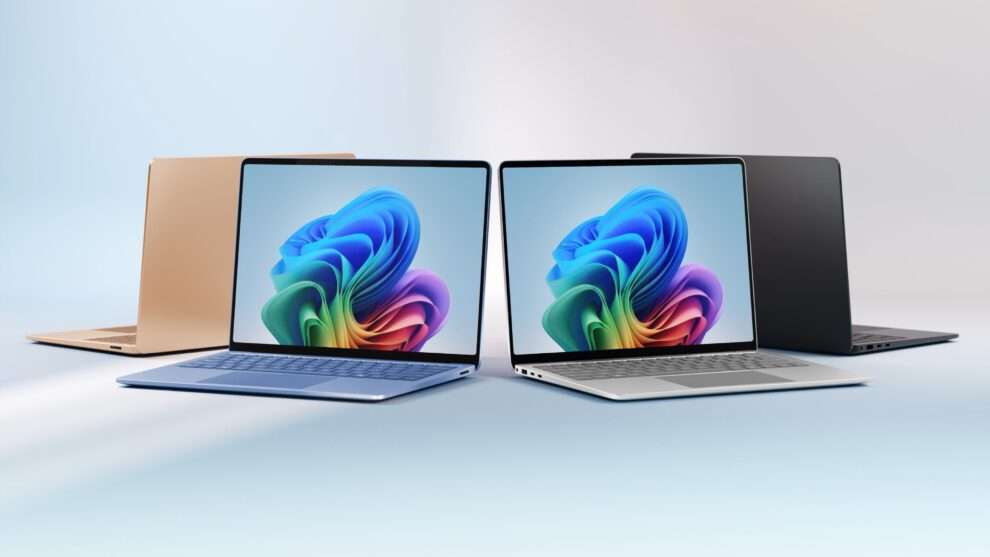Microsoft’s latest Surface Laptop 7 release marks a pivotal moment in personal computing, offering consumers a choice between Intel and Qualcomm processors, both optimized for next-generation AI experiences through Copilot+. This watershed launch represents the first time Microsoft has simultaneously offered its flagship laptop with such distinctly different architectural approaches, each bringing unique advantages to the mobile computing landscape.
The Intel variant of the Surface Laptop 7 comes equipped with the latest 14th-generation Core Ultra processor, featuring a dedicated neural processing unit (NPU) specifically designed for AI workloads. This sophisticated chip architecture builds upon decades of x86 computing excellence, promising seamless compatibility with traditional Windows applications while pushing forward into the realm of AI-accelerated computing.

Meanwhile, the Qualcomm-powered model showcases the ambitious Snapdragon X Elite platform, representing the ARM-based chipmaker’s most powerful entry into the PC market to date. This processor leverages Qualcomm’s extensive mobile expertise, promising extraordinary battery life alongside competitive performance metrics that challenge conventional expectations for ARM-based Windows devices.
Performance characteristics between the two variants reveal interesting tradeoffs. The Intel model demonstrates superior raw computing power in traditional workloads, particularly excelling in single-threaded applications and legacy software execution. Professional creative applications like Adobe Premiere and AutoCAD run natively without any emulation overhead, delivering the performance levels demanding users expect from a premium laptop.
Qualcomm’s offering shines in different areas, particularly in tasks optimized for its neural engine. The Snapdragon X Elite shows remarkable efficiency in AI inferencing tasks, with Copilot+ features responding more quickly and consuming less power compared to its Intel counterpart. Basic productivity tasks feel remarkably snappy, and the system maintains consistent performance even under sustained loads.

Battery life emerges as a critical differentiator between the two models. The Qualcomm variant demonstrates exceptional endurance, regularly achieving 18-20 hours of real-world usage, significantly outpacing the Intel model’s respectable but more conventional 10-12 hour runtime. This advantage becomes particularly noticeable during AI-intensive tasks, where the Snapdragon’s efficient architecture maintains its power advantage.
Display technology remains consistent across both variants, featuring Microsoft’s signature 3:2 aspect ratio PixelSense display. However, the Qualcomm model includes enhanced display features, such as advanced adaptive refresh rate capabilities that can scale from 1Hz to 120Hz depending on content, contributing to its superior battery life while maintaining smooth visual performance.
Connectivity options differ significantly between the two versions. The Qualcomm model integrates 5G capabilities as a standard feature, leveraging the company’s telecommunications expertise. The Intel variant relies on Wi-Fi 7 and optional 4G LTE, though this configuration may better suit users primarily working within Wi-Fi coverage areas.
Software compatibility presents nuanced considerations for potential buyers. The Intel version maintains complete compatibility with Windows’ vast software library, running both 32-bit and 64-bit applications natively. The Qualcomm model, while showing impressive improvements in emulation performance, may still encounter occasional compatibility challenges with some specialized software, though Microsoft’s continued optimization efforts progressively minimize these instances.
Thermal management and noise levels favor the Qualcomm variant, which operates silently under most conditions and maintains cooler surface temperatures. The Intel model, while well-engineered, requires more active cooling during demanding tasks, resulting in occasional fan noise and warmer external temperatures.
Price positioning reflects the different value propositions, with the Intel variant commanding a slightly higher premium in similarly configured models. However, the Qualcomm version’s integrated 5G capability and enhanced battery life may justify its cost for mobile professionals prioritizing connectivity and endurance.
Corporate deployment considerations vary based on organizational needs. Businesses heavily invested in legacy software environments may prefer the Intel variant for its guaranteed compatibility. Organizations embracing cloud-first approaches and prioritizing mobility might find the Qualcomm model’s extended battery life and built-in connectivity more compelling.
The Surface Laptop 7’s dual offering represents Microsoft’s strategic vision for the future of personal computing, where AI acceleration becomes a fundamental aspect of the computing experience. Both variants excel in different scenarios, making the choice less about absolute superiority and more about matching specific user needs with each platform’s strengths.

As Windows continues to evolve with AI-powered features through Copilot+, both processor platforms demonstrate compelling advantages. The Intel variant offers a safer choice for users requiring guaranteed software compatibility and maximum performance in traditional computing tasks. The Qualcomm model presents an exciting glimpse into a future where mobile efficiency meets desktop-class performance, particularly excelling in next-generation AI workloads and extended mobility scenarios.
The decision between these two variants ultimately depends on individual priorities regarding battery life, performance requirements, software compatibility, and connectivity needs. Both represent impressive achievements in mobile computing, showcasing how different architectural approaches can deliver compelling experiences in the emerging era of AI-enhanced personal computing.
















Add Comment